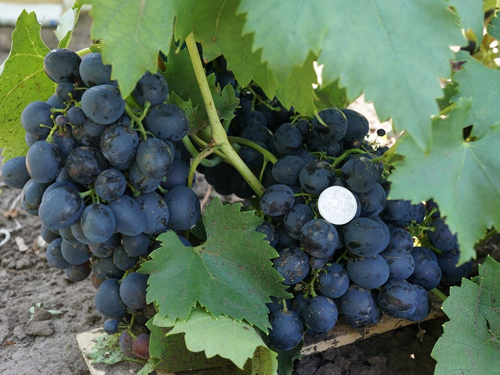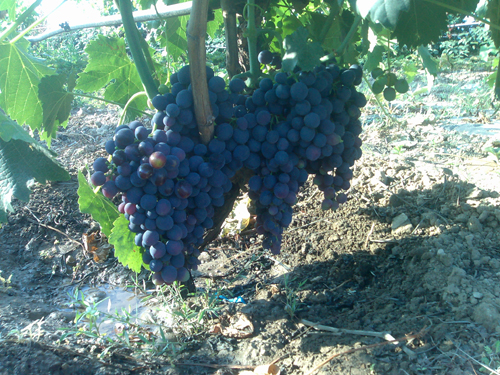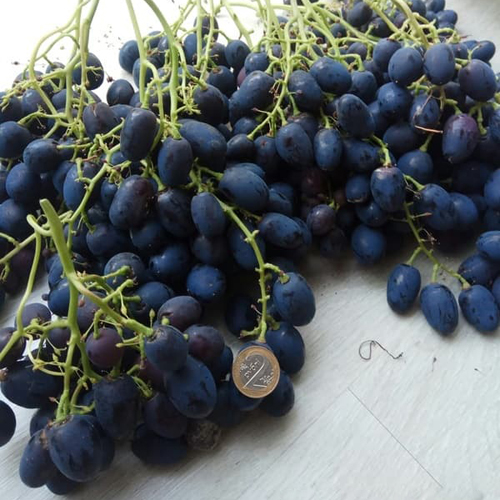Sphinx grape variety
Sphinx is a fairly new table hybrid form of grapes, obtained in the early 2000s in Zaporozhye (Ukraine) by the famous local folk breeder Vitaly Zagorulko. Vitaly Vladimirovich began to develop new varieties of culture in the 90s of the last century, and therefore the hero of our article can be considered one of his early works. At the moment, many do not consider it outstanding, since over the past years, both Zagorulko himself and his colleagues in the research craft have born many more interesting hybrids with an impressive appearance, taste and aroma of fruits. But, nevertheless, it continues to be cultivated by a very large number of winegrowers in the post-Soviet space, and therefore it is too early to write it off.

The form was bred as a result of crossing known varieties Strashensky and Timur... The main advantages for which our hero is praised are high strength of growth and increased resistance to diseases. Otherwise, it shows itself to be average, which is why we often hear from many owners about the desire to replace it with more promising varieties of grapes.
Agrobiological characteristics
Bushes grow vigorous, well-developed, with a strong annual growth. The crown of the young shoot is light green, almost without pubescence. The leaves of the Sphinx are large, rounded, predominantly five-lobed with a medium dissection. The surface of the leaf is reticulate-wrinkled, the profile is wavy. Top side cutouts are open, medium depth, slotted or V-shaped. The lower notches are an order of magnitude smaller, often barely outlined, or completely absent. Petiolate notches are lancet and vaulted with a pointed bottom. The petioles are long, several tones lighter in color than the leaf, without anthocyanin pigmentation. The teeth along the edge of the vine leaf are high, triangular and saw-shaped, most with rounded edges and sharp tops. The flowers are bisexual, but the pollen does not differ in high fertility, which is why peas of berries and excessive loosening of the bunches are often found, giving them an unattractive appearance. Flowering occurs at a later date, which protects the generative organs from late spring frosts and contributes to the stability of fruiting. The growth of the current year does not ripen at the earliest dates, but, nevertheless, almost the entire length. Ripe shoots become dull brown.

The bunches of the variety with normal pollination are quite large - with an average weight of 500-700 grams, a cylindrical-conical shape and an average degree of density. Deformation of grapes in the cluster and their damage to each other is not noted due to their relatively free arrangement. At the same time, the hybrid often cannot boast of high uniformity of grapes. The berries are large, reach 32 mm in length, 28 mm in diameter, and average weight 8-10 grams. Their shape can be oval or ovoid, the color is dark blue, the surface is covered with a thick layer of gray protective wax coating. The flesh of the Sphinx is quite dense, crispy, with a simple, neutral taste, and no bright features in the aroma. Sugar accumulation in the early stages of harvesting is low, which also explains a certain inexpressive taste. However, when the full ripeness of the bunches is reached, the sweetness of the pulp and juice still begins to manifest itself. The skin is quite tough, yet chewable and eaten. Medium-sized seeds, up to three in number, are felt during tasting. The general taste assessments of the berries are satisfactory, improving only with prolonged exposure to the vine.
The grapes are used for fresh consumption, however, according to many farmers, the variety is not "marketable".Firstly, it lacks the attractiveness of its appearance, which is why it loses the competition to more marketable varieties, and secondly, as already mentioned, with early harvest it has an inexpressive taste, and later the market is already flooded with grapes of a wide variety of shapes and colors. , and our hero is lost in all this diversity. To a greater extent, it is suitable for cultivation in garden and garden plots for own consumption and use as a raw material for home preservation. In particular, compotes, preserves and jams, excellent in taste and rich in color, are taught from it. At the same time, the suitability of the harvested crop for storage is low. Even for a short storage period, it is necessary to create optimal conditions for temperature and humidity, otherwise there is a high risk of damage to the crop. Its transportability is also not up to par, which is why it is not adapted to travel long distances.

The author ranks his brainchild as a group of varieties with a very early ripening period. According to him, it is enough for the Sphinx to achieve removable ripeness of only 100-105 days from the day of budding. However, variety testing carried out by numerous winegrowers has shown that this is not entirely true. The hybrid really differs in the early coloring and softening of the berries, which makes them formally edible by this time. However, the slow accumulation of sugar is the reason that the ripe-looking berries turn out to be of very mediocre taste at this time. To achieve acceptable gastronomic characteristics, the crop needs to hang on the vine for another two weeks, which automatically translates it into the category of mid-early with a growing season of 120-125 days and the sum of active temperatures required for ripening 2500-2600 ° C. In the south, it reaches optimal conditions only by the end of the first decade of August. Residents of unconventional regions of viticulture should not be deluded by the harvesting dates declared by the originator, at which the grapes are actually unripe, and therefore, to the north of the Central Black Earth zone, this hybrid is likely to disappoint its owners.
The yield of the variety, like many of its other characteristics, is at an average level, and largely depends on the quality of pollination of the inflorescences. If fertilization has passed sufficiently and the bunches are fully developed, then you can count on getting up to 15 kg of grapes from an adult, well-developed Sphinx bush. To a certain extent, he may be prone to overload, but does not show the appearance, powerfully "drives" the vine, which is sufficiently ripe. But at the same time, it is not necessary to abuse this property, trying to load the bushes moderately, in accordance with their age, sufficiency of nutrition and moisture supply. Not showing itself in the current season, congestion often negatively affects the fertility of the buds being laid, which next year will naturally cause problems with flowering and fertilization, and therefore with productivity. And the grower, out of habit, will begin to blame the variety or the weather for everything, but will not even think about the fact that such problems may be associated with his own mistakes.
Once ripe, the grapes can and should remain on the bushes in order to gain sufficient sugar and achieve acceptable tasting characteristics. In this case, it is necessary to take into account the predisposition of the hybrid to cracking of berries as a result of prolonged damp weather during ripening, or a sharp change in soil moisture during this period. In addition, wasps and sometimes birds show great interest in berries, which also requires the attention of the grower and measures to protect the crop.
Agrotechnical features
The Sphinx can be considered an underrated variety in many ways. If you carefully understand its agrobiology and take into account its specifics in the course of cultivation, then you can get significant yields of good quality fruits from it. And if we add to this the fact of its increased resistance to disease, then we can even speak of it as a very successful variety.
When planning planting, first of all, you need to pay attention to the provision of grapes with warmth on your site. If the requirements for full maturation of the hybrid are not critical for a particular region, then planting can be carried out anywhere except lowlands and slopes of cold exposures. If the climatic conditions are risky for it, it is better to use the warmest places on the southern side of various buildings for it, where the sum of active temperatures is several hundred degrees higher than in open areas. A similar advantage lies in the establishment of a vineyard in the upper part of the southern slope.
The variety has not been tested for resistance to root phylloxera, and therefore, in the zones of soil contamination by this pest, it is strongly recommended to reproduce this form with grafted phylloxera-resistant seedlings. If you ignore this recommendation, there is a high chance of losing plants within a few years after planting. If the root aphid is guaranteed to be absent in the region, then it will not be difficult for every winegrower, regardless of his experience, to root the cuttings of the Sphinx, and thus independently obtain planting material. When planting, it is worth strictly maintaining certain distances between vigorous bushes of grapes, so that, having entered fruiting, they do not compete with each other for mineral nutrition, moisture and sunlight. Each plant must be allocated at least 4.5-5 square meters of land.
The frost resistance of the variety is -23 ° C, and this parameter must be taken into account when choosing a scheme for maintaining a bush (covering or non-covering), and therefore its formation. For non-covering crops, high-stamped cordon forms are usually used, due to which the microclimate in the crown and fruit zone of plants is improved, and in the absence of such an opportunity and the need for warming the vines for the winter, they choose squat, non-stamped options - an oblique cordon or a multi-arm fan.
The load of fruiting grape bushes is chosen in accordance with their age and vitality, leaving on average 30-40 eyes when pruning with the length of fruit arrows about 4-6 buds. Infertile and weak shoots are traditionally removed when broken, leaving up to 24 fruitful ones, on each of which the bunches are additionally thinned out, keeping one per shoot.
The variety responds well to an increase in the agricultural background, and especially to regular watering, which, in addition to increasing yields, helps to reduce the risk of berry cracking due to sudden changes in soil moisture.
Diseases of the Sphinx are weakly affected, and therefore it is possible to grow an ecologically clean crop with a minimum amount of fungicide treatments performed in the early stages of the growing season. To protect the grapes from wasps, the bunches are placed in special bags, where they will be safe until the very harvest.









I really like grapes with dark berries - this variety grows with me, I will say right away - grapes are problematic for my climate, but I like it so much that I have adapted to its whims.Its binding is bad, so I treat the flowering brushes with the preparations "Ovary" or "Bud" - this is the only way to avoid peas. The brushes grow large, but they start singing late, so you have to strictly ration their number, otherwise I will not have time to try the crop, nor the vine will be able to ripen. But the immunity and frost resistance of the Sphinx are excellent.